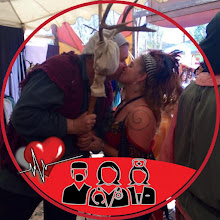Early on in this blogs first run, I made a post about orcs in general. But my friend "L" has recently been reading a book called "Orconomics" or something like that which got me thinking a bit about them. Not so much as "what are they," but what I have had them be in the past and present.
For sure I have gone back and forth about the general nature of orcs. For most of my DMing life I have had them be of the almost demonic Tolkien variety. Murderous, hateful, cannibalistic. Other times, like now, I have backed a little bit off my belief that most human women would rarely survive an assault scenario. But there are a lot of half orcs characters in my games the last few years. For many years now various media (video games, non D&D rpgs, etc) often portray orcs as more or less barbarians, though sometimes noble. I've resisted that interpretion. I think its pretty boring just to make them human-like thugs or barbarians. Hateful and inherently and irredeemably evil beyond human ability to be so are my orcs. Orcs, elves, dwarves, halflings; I like them to be pretty much drilled down into a single type of personality with particular behaviors. Its humans who should have the wide variety of behaviors. Saintly to thuggish.
I have found over the years that everybody has a kind of orc they like. I guess my biggest change to them, starting around the late 90's up into more recent years, was to have goblins and bugbears just be different sizes of orc. Goblins are the wee ones, and bugbear stats used to signify Uruk Hai types.
I may be totally wrong, but my impression from LOTR goblins were indeed just low forms of orc. The original hobbit of course had them be goblins, a separate race. Peter Jackson went that way with them. I think the old Rankin Bass Hobbit cartoon had them as goblins.
This kind of made it easy on me. I did not feel I needed a wide diversity of humanoid types. With gnolls, kobolds, ogres, etc. around there seemed to be plenty.
I think it was several years ago when I used The Keep on the Borderland's Caves of Chaos that I started going back on this notion a bit. The caves are a highly diversified series of apartment flats sectioned off by race. Orcs, goblins, gnolls, bugbears. At this point it was harder to think in terms of "ok, small orcs are over here, and a bunch of Uruk Hai are over there. " Doable but felt a little awkward to me. My thinking would have made the other races quite outnumbered by orcish types.
But it was my adopting 5th edition about 3 years ago that had me breaking up the orcish diversity thing. In old edition the humanoids are mostly divided up by HP, AC, and damage ability. But in 5th things are way more unique. Advantages and such giving them specialties. Abilities to gang up on foes, charge their foes, etc. So I parse them back out. Goblins have zero relation to orcs. Back to being creatures more akin to Brownies and Red Caps of legend.
 |
| "I'm a goblin. In a red cap." |
And I think I prefer it. I like to think of goblins classically, more mischievous than outright bloodthirsty, but also often murderous. A single blade-wielding goblin coming up in the dark to stab you in the back, or a small gang of them looking to take down a loot a "big'un." But also capable of just being families of mushroom farmers in the upper caves of the world, wanting to be left alone. My basic orcs are less diverse. They just want to torture you, kill you and maybe eat you.
Bugbears are back to being their own thing as well, though I might still look to them as examples of nice big badass Uruk's.
We just won't mention what they are like per Runequest.




















The thing you're calling a "Runequest bugbear" is a jack-o-bear, a Chaotic critter that looks and acts less like a D&D bugbear than the similarly chimerical owlbear does. Just because the names all include "bear" doesn't make them the same thing, or even related. Doesn't even work as an attempted joke.
ReplyDeleteFair enough, though I beg to differ to at least some degree (not that I am defending my weak attempts at humor). But instead of a rebut here I decided to do a little post of it as my Sunday afternoon is a bit slow.
ReplyDeleteIn Tolkien, goblins and orcs are two names for the same thing. So the Uruk-hai are "goblin-soldiers"; their leader's head on a spike (after the fight with Eomer and the Riders of Rohan) is a "great goblin head", and individuals such as Azog and Grishnakh (both big orcs and almost certainly Uruks) are described as both orcs and goblins.
ReplyDeleteIn the introduction to The Hobbit, JRRT explains that the non-English word "Orc" is usually translated as "goblin". He also says that "hobgoblin" is sometimes used for the larger kinds, but he dropped this idea later (according to his letters) when he discovered that hobgoblins were originally small, domestic goblins rather than large, fierce ones (although the English word later evolved the latter connotation - by the Jacobean period, as I recall).
Interesting about the hobgoblins. I always thought “bigger and better.” Maybe because Marvels Hobgoblin seemed an upgraded Green Goblin :)
ReplyDelete